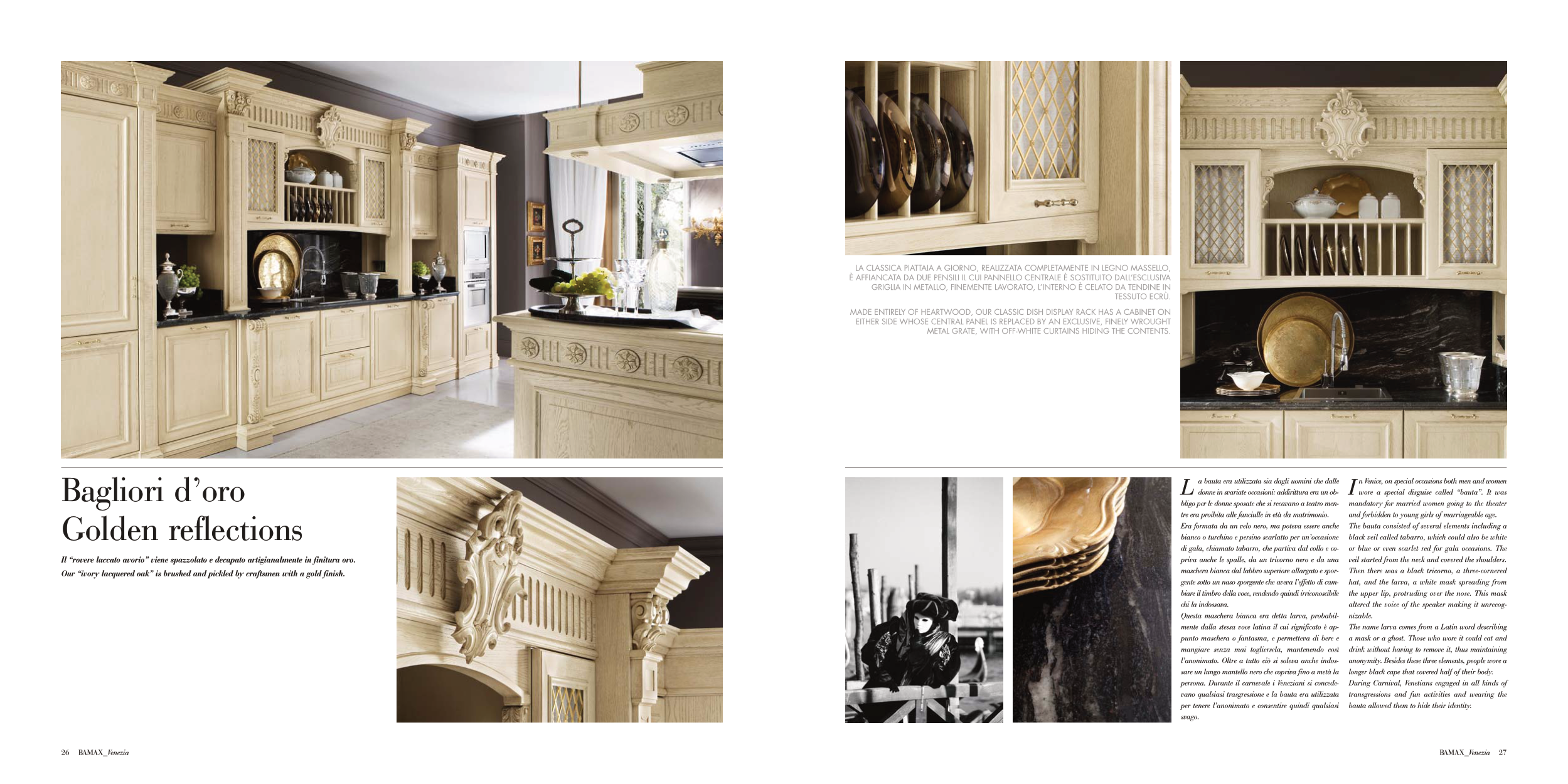26
BAMAX_Venezia
Il “rovere laccato avorio” viene spazzolato e decapato artigianalmente in finitura oro.
Our “ivory lacquered oak” is brushed and pickled by craftsmen with a gold finish.
Bagliori d’oro
Golden reflections
BAMAX_Venezia
27
L
a bauta era utilizzata sia dagli uomini che dalle
donne in svariate occasioni: addirittura era un ob-
bligo per le donne sposate che si recavano a teatro men-
tre era proibita alle fanciulle in età da matrimonio.
Era formata da un velo nero, ma poteva essere anche
bianco o turchino e persino scarlatto per un’occasione
di gala, chiamato tabarro, che partiva dal collo e co-
priva anche le spalle, da un tricorno nero e da una
maschera bianca dal labbro superiore allargato e spor-
gente sotto un naso sporgente che aveva l’effetto di cam-
biare il timbro della voce, rendendo quindi irriconoscibile
chi la indossava.
Questa maschera bianca era detta larva, probabil-
mente dalla stessa voce latina il cui significato è ap-
punto maschera o fantasma, e permetteva di bere e
mangiare senza mai togliersela, mantenendo così
l’anonimato. Oltre a tutto ciò si soleva anche indos-
sare un lungo mantello nero che copriva fino a metà la
persona. Durante il carnevale i Veneziani si concede-
vano qualsiasi trasgressione e la bauta era utilizzata
per tenere l’anonimato e consentire quindi qualsiasi
svago.
I
n Venice, on special occasions both men and women
wore a special disguise called “bauta”. It was
mandatory for married women going to the theater
and forbidden to young girls of marriageable age.
The bauta consisted of several elements including a
black veil called tabarro, which could also be white
or blue or even scarlet red for gala occasions. The
veil started from the neck and covered the shoulders.
Then there was a black tricorno, a three-cornered
hat, and the larva, a white mask spreading from
the upper lip, protruding over the nose. This mask
altered the voice of the speaker making it unrecog-
nizable.
The name larva comes from a Latin word describing
a mask or a ghost. Those who wore it could eat and
drink without having to remove it, thus maintaining
anonymity. Besides these three elements, people wore a
longer black cape that covered half of their body.
During Carnival, Venetians engaged in all kinds of
transgressions and fun activities and wearing the
bauta allowed them to hide their identity.
LA CLASSICA PIATTAIA A GIORNO, REALIZZATA COMPLETAMENTE IN LEGNO MASSELLO,
È AFFIANCATA DA DUE PENSILI IL CUI PANNELLO CENTRALE È SOSTITUITO DALL’ESCLUSIVA
GRIGLIA IN METALLO, FINEMENTE LAVORATO, L’INTERNO È CELATO DA TENDINE IN
TESSUTO ECRÙ.
MADE ENTIRELY OF HEARTWOOD, OUR CLASSIC DISH DISPLAY RACK HAS A CABINET ON
EITHER SIDE WHOSE CENTRAL PANEL IS REPLACED BY AN EXCLUSIVE, FINELY WROUGHT
METAL GRATE, WITH OFF-WHITE CURTAINS HIDING THE CONTENTS.


